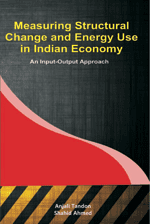
Author(s): Anjali Tandon & Shahid Ahmed
Publishers: Bookwell, Delhi
Pages: xxii, 277
2019 Edition
ISBN: 978-93-865784-6-4 (Hardbound)
Measuring Structural Change and Energy Use in Indian Economy: An Input-Output Approach
The Book in Brief
This book focuses on the link between changing structure of the Indian economy and energy use, which is of immense importance in view of the possible substitutions, across different fuel types within industries and processes, to cleaner fuels which are efficient or less emitting. The book analyses various aspects related to energy use such as the changing sectoral interdependence of energy sectors in the economy, sources of change in energy use over time, and the implications in terms of changing basket of goods and services traded internationally by India. Through an application based approach, using tools for economic analysis to study energy related issues, the book studies the impact of policy reforms with the help of transaction flows across sectors in an economy-wide framework. The time frame of analysis in the book covers policy changes implemented during the first and second generation reforms which had focus on output expansion and efficiency improvement in the Indian economy, respectively. The authors make a qualification to consider electricity generated from primary energy sources, particularly the hydroelectricity, as a separate source of energy use. This methodological consideration in the analysis contributes not only through a wider coverage of energy sources but also improves the precision of computations used to evaluate change in energy intensity of different sectors and the overall economy. Analysis in the book underpins the technological changes resulting from inter-fuel substitution. The analysis in the book also provides insights on energy embodied in the consumption and trade basket of India. The book notes that foreign trade of an economy can have unintended implications on energy use through transfer of energy manifested indirectly in the non-energy transactions, thus emphasising on the energy deficit of the Indian economy due to imports of energy embodied in non-energy sectors. The book serves readers across academia, research and policy makers through informed reading from the quantified facts based on economic models. It assists scholars to strengthen their understanding, learning and application of a technique. It is also helpful for the reader to apply the theory into practice.
ABOUT THE AUTHOR
Anjali Tandon is an Associate Professor with the Institute for Studies in Industrial Development (ISID). She has research experience of over 20 years. Her research interests include international trade, energy and FDI. She has been a contributor to the GTAP database of the Purdue University. She is the recipient of doctoral fellowship from Indian Council of Social Science Research, Ministry of Human Resource Development, Government of India. Her past positions include Associate Fellow at the National Council of Applied Economic Research (NCAER). She has authored academic papers in refereed journals and opinions in print media.
Shahid Ahmed is a Professor in the Department of Economics, Jamia Millia Islamia (JMI), New Delhi. He has served as Head, Department of Economics, Director, Centre for Jawaharlal Nehru Studies, and Finance Officer of JMI. Earlier, he has also served as Senior Economist in UNCTAD. He has been teaching economics in the Department for more than 21 years and supervising research scholars in the field of trade and development. He has been the member of Academic Council, Executive Council and the Court of JMI. He has 5 books to his credit on issues related to International Trade and Development and has authored more than 90 research papers published in reputed national and international journals.
CONTENTS
Chapter 1: The Challenges of Energy Economy
Chapter 2: Reflections on Global Research Measuring Structural Change from Energy Perspective
Chapter 3: Measuring Structural Change – An Input-Output Approach
Chapter 4: Overview of India’s Energy Sector
Chapter 5: Assessing Economic Landscape through the Linkage Lens
Chapter 6: Demand Shifts and Technological Change –A Structural Decomposition of Changing Energy Use
Chapter 7: Implications of Changing Pattern of Trade on Energy Use
Chapter 8: Conclusions and Policy Implications
Media/Press Release
- International Input-Output Newsletter, Number 43, February-March 2020
- PRO-Media Coordinator’s Office, Jamia Millia Islamia, November 21, 2019
- Social Media Page, Jamia Millia Islami, November 21, 2019
- Education Today, India Today, November 22, 2019
- India Education Diary November 22, 2019
- ARTNeT Newsletter November 2019

